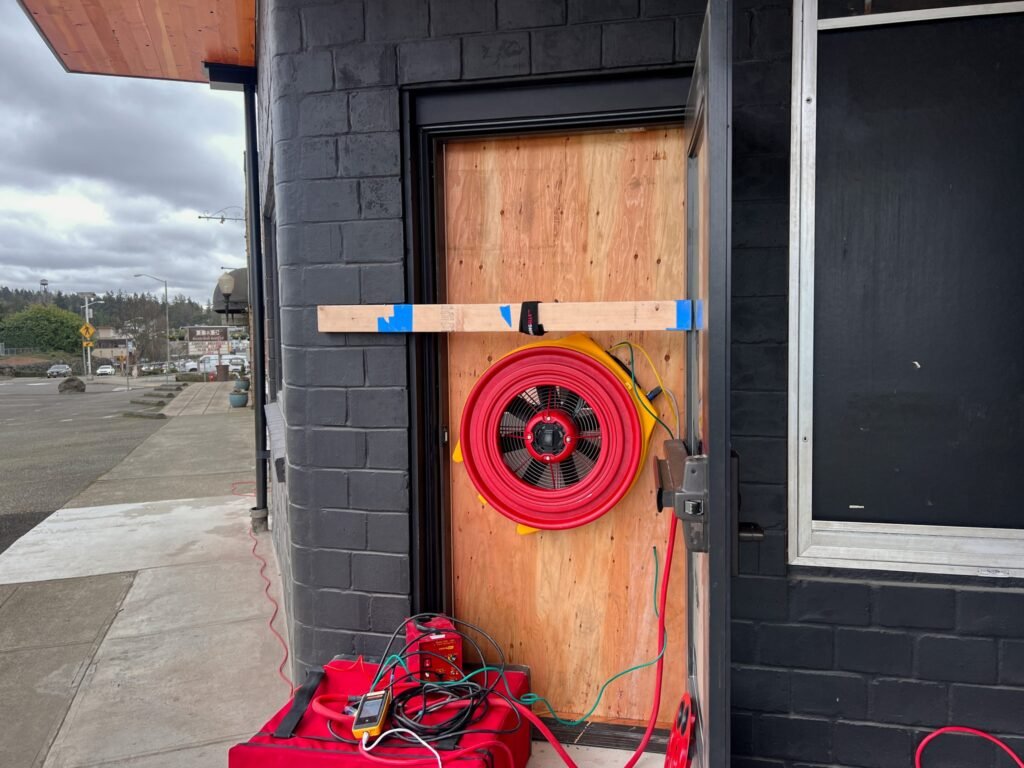When it comes to energy efficiency and building performance, blower door testing in Oregon is one of the most effective ways to measure how airtight a structure really is. Both residential and commercial buildings in Oregon must meet specific air leakage requirements under the International Energy Conservation Code (IECC) and related standards like ASTM E779, ASTM E1827, and ASTM E3158. While the goal is the same reducing uncontrolled air leakage—the methods, equipment, and performance targets differ significantly between residential and commercial testing.
In this article, we’ll break down the key differences between residential blower door testing in Oregon and commercial blower door testing in Oregon, why they’re both important, and what standards govern each process.

What Is Blower Door Testing?
Blower door testing is a diagnostic method used to measure how much air leaks through gaps, cracks, and penetrations in a building’s envelope. A calibrated fan is temporarily installed in an exterior doorway to pressurize or depressurize the structure while measuring airflow and pressure changes. The results reveal the building’s overall air leakage rate, helping to identify inefficiencies and improve energy performance.
In Oregon, blower door testing has become a key requirement for new construction and major renovations as part of energy code compliance. Both residential and commercial projects are tested to ensure they meet the state’s energy conservation standards.
Residential Blower Door Testing in Oregon
For homes and smaller residential structures, testing is governed primarily by ASTM E779 and ASTM E1827.
- ASTM E779 in Oregon outlines the standard method for determining air leakage rates using a fan pressurization system. This test measures air changes per hour (ACH50), or how many times the home’s air volume is exchanged every hour at 50 Pascals of pressure.
- ASTM E1827 in Oregon provides an alternative procedure that can also be used to determine airtightness, often favored for smaller or simpler structures.
Under the 2021 Oregon Residential Specialty Code (ORSC), new homes are typically required to achieve an air leakage rate of 3 ACH50 or less, depending on climate zone.
Residential blower door testing typically uses a single fan system, as the volume of air within a home can be accurately measured with smaller equipment. The results help builders and homeowners identify problem areas—like leaky windows, poorly sealed attics, or gaps around plumbing and electrical penetrations—and make improvements that lower utility costs and improve comfort.
Commercial Blower Door Testing in Oregon
Commercial and multifamily buildings require more advanced testing methods due to their larger size and complex mechanical systems. These projects are typically tested using ASTM E3158 in Oregon, which is the standard test method for measuring the air leakage rate of large or multizone buildings.
Unlike residential testing, commercial blower door testing in Oregon often involves multiple high-capacity fans and sophisticated monitoring equipment to ensure accurate results. The test is conducted under 75 Pascals of pressure, and the performance target is usually expressed in CFM per square foot (CFM/ft²) of building envelope area rather than air changes per hour.
The Oregon Energy Efficiency Specialty Code (OEESC) references IECC Section C402.5, which sets the maximum allowable leakage rate for most new commercial buildings at 0.40 CFM/ft² at 75 Pa. This means the tighter the building envelope, the better it performs in terms of energy conservation and indoor environmental quality
Why These Tests Matter
Both residential and commercial blower door tests are critical for ensuring buildings meet Oregon’s energy efficiency goals. Air leaks lead to wasted energy, higher heating and cooling costs, and potential moisture issues that can cause long-term damage.
By following industry standards like ASTM E779 in Oregon, ASTM E1827 in Oregon, and ASTM E3158 in Oregon, builders and engineers can accurately verify compliance, enhance building durability, and improve occupant comfort. These tests also support Oregon’s broader sustainability initiatives by reducing carbon emissions and improving building performance statewide.
Professional Blower Door Testing in Oregon
Whether you’re building a new home or managing a large commercial project, partnering with an experienced testing agency ensures compliance and accurate results. Certified professionals use calibrated equipment, adhere to ASTM and IECC standards, and provide detailed reporting to document compliance with Oregon’s energy code.
If you’re planning a project that requires blower door testing in Oregon—residential or commercial—work with a qualified testing lab that understands both ASTM and Oregon-specific code requirements. A properly executed blower door test not only meets state mandates but also improves the efficiency, safety, and long-term value of your building.
Final Thoughts
In short, residential blower door testing focuses on smaller-scale airtightness and occupant comfort, while commercial testing addresses the complex dynamics of large buildings and stringent energy code compliance. Both play a vital role in achieving Oregon’s energy efficiency standards—and both rely on trusted testing methods like ASTM E779, ASTM E1827, and ASTM E3158 to ensure accuracy and performance.
